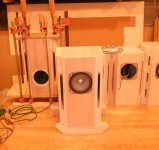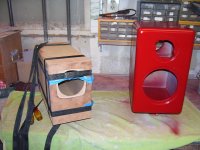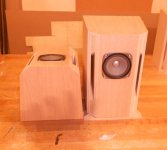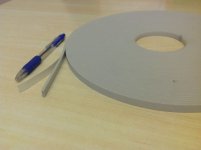The pair I have show this but it looks to me to be a by-product of the forming of the paper/pulp cone as opposed to an intentional pattern applied for a purpose.
Would it not then appear on their other woofers also?
You could be right though. It is possible instead of improving things it might actually make things worse

Last edited:
What's ugly? Use a belt sander and use the large round over bit...It will be nice.
Now that I see your red box......I've have good luck spraying light coats of "regular" oil house paint. It takes a while to dry, but always looked nice.
Now that I see your red box......I've have good luck spraying light coats of "regular" oil house paint. It takes a while to dry, but always looked nice.
Yea, I decided not to go with expensive paint as I came up with more ideas for future boxes. I wanted to get them into the living room sooner than later. So, finish by Krylon. I was finally happy with my process/skill in getting the primer right.
The Fostesx will get the full round-over, plus a 1/8 full face felt pad. Standard round cardboard port out the back. Doing the rabbits on an angle took a few tries. I am still learning which to do in the table saw and which to do in the router table. Getting better. I spent too many years with a RAS and a 1/4 inch sears router. Way too many "hand crafted" results.
The Fostesx will get the full round-over, plus a 1/8 full face felt pad. Standard round cardboard port out the back. Doing the rabbits on an angle took a few tries. I am still learning which to do in the table saw and which to do in the router table. Getting better. I spent too many years with a RAS and a 1/4 inch sears router. Way too many "hand crafted" results.
Playing with bits of foam tape on an old Radio Shack poly woofer. Really significant differences in breakup. I was thinking of other materials. Everything from the dip-it handle goo to 3M weatherstrip adhesive. One would need to be symmetrically asymmetric so as not to get the mass off center.
If you have seen the Seas FA22, they have a cone with small dimples all over it. It would not surprise me if this is done for the exact same reason that people claim that ENABL works
I've read a discussion where the dimpling of a speaker was detailed. IIRC it was with a 4" Tang Band driver. I have also seen a discussion about a 4" full range Tang Band where there was blue tac used on the back close to the edge. Both methods were designed to minimize/stop breakup. There is also a Tang Band that has a pattern imprinted on the cone. The Fostex Sigma series has cones that are having a pattern.
I am having some very positive results with foam dots on a old poly 7 inch. I dropped the lowest peak by 6 dB leaving the remaining problems 2K higher. The idea looks viable.
The goal here is to see what the hub-bub is about. My basic understanding of physics and experience with speakers says you can't get a reasonable musical speaker from one driver like this. Single drivers have quite a following. Instead of using my soapbox, as I use it more than enough, I am trying it before I decry it. This is the first shot. I have a pair of Fountec to play with and if I get anywhere, may try a pair of Mark Audio.
So far:
I know, if the FF125wk is going into a box and you expect any semblance of balance top to bottom, you will be using a network.
I know the breakup mode has to be dealt with, mechanically or with a crossover or I can't stand it.
I know the harmonic distortion is higher than other drivers I have tried.
So, this specific driver is not looking good.
The goal here is to see what the hub-bub is about. My basic understanding of physics and experience with speakers says you can't get a reasonable musical speaker from one driver like this. Single drivers have quite a following. Instead of using my soapbox, as I use it more than enough, I am trying it before I decry it. This is the first shot. I have a pair of Fountec to play with and if I get anywhere, may try a pair of Mark Audio.
So far:
I know, if the FF125wk is going into a box and you expect any semblance of balance top to bottom, you will be using a network.
I know the breakup mode has to be dealt with, mechanically or with a crossover or I can't stand it.
I know the harmonic distortion is higher than other drivers I have tried.
So, this specific driver is not looking good.
I've attached a picture of the roll of adhesive foam I've most recently used to this post, which is 10mm wide by 3mm thick and grey in colour. It's sticky on only one side, quite flexible, and has a peel off paper backing strip.Exactly what foams you have tried would be interesting.
It may be quite similar to the 3M weatherstripping that you mention below.
When you say foam tape do you mean the thin stiff stuff that is sticky on both sides that you would use for sticking objects onto a smooth surface ?Playing with bits of foam tape on an old Radio Shack poly woofer. Really significant differences in breakup. I was thinking of other materials. Everything from the dip-it handle goo to 3M weatherstrip adhesive.
I've tried that as well and although it does certainly add damping - more than the strips I use in fact, I found the problem with it is that it is actually too stiff to stick smoothly and evenly to a curved surface such as the back of a speaker cone - over a period of a few hours it kept letting go at the ends and flattening out leaving only the middle of the strip touching, with the corresponding loss of damping. It just wasn't physically stable when stuck to a curved surface, and didn't bond very well to the paper.
The stuff I use is considerably softer and effortlessly bends to follow the curve of the cone, and I now have speakers that have had the strips applied for 8 years and they have not peeled up at the edges, so I know the long term stability is good. In fact if anything the bond is more secure to the point where I can no longer remove them without peeling off a surface layer of paper... 😛
Yes indeed. If you look at the pattern of strips in the first thread I linked to you'll see (if you turn your head 22.5 degrees to one side) that the pattern has 4 fold symmetry, and every strip has an equal and opposite that is at the same radius...thus the centre of mass stays along the centre axis..One would need to be symmetrically asymmetric so as not to get the mass off center.
Excellent. Do you have any before/after measurements to share ? At what frequency was the original 6dB peak ? Did you just add foam at one radius or did you stagger it like my pattern ? If there is another peak a bit higher in frequency you may be able to deal with that too, by having some additional strips closer to the centre. (As per my staggered layout)I am having some very positive results with foam dots on a old poly 7 inch. I dropped the lowest peak by 6 dB leaving the remaining problems 2K higher. The idea looks viable.
From a driver the size of a ff125wk, no... wide range maybe, at modest SPL, full range, no.The goal here is to see what the hub-bub is about. My basic understanding of physics and experience with speakers says you can't get a reasonable musical speaker from one driver like this.
Although I'm sure many will disagree with me I still think an 8" driver is the minimum comfortable size for a "true" full range speaker, at least in a closed or bass reflex box. Any smaller than that and it simply won't have enough bass extension, nor enough SPL capability at low distortion to be considered full range.
I would also suggest that a closed box is sub-optimal for any full range driver as finding a single size of driver that can cover from bass to treble is a real stretch - so anything that can be done to make the drivers life easier needs to be done - at the bass end a bass reflex design is going to give you considerably better bass extension for the same cone diameter, a sealed box approach would require a larger cone for a similar bass performance which is then not going to perform as well at the high end...
IMHO if you want the best results from pretty much any full range driver you really do need either line level EQ or a simple passive EQ network, because at the very least you have BSC to deal with, and typically you have at least one or two resonances that need compensating with notches.So far:
I know, if the FF125wk is going into a box and you expect any semblance of balance top to bottom, you will be using a network.
I've never really understood the obsessive minimalist approach to full range designs, that denounce even BSC let alone more complex EQ. While some drivers can sound "OK" with little or no correction they certainly aren't optimal, and some carefully done EQ can transform an OK sounding full range system into one that sounds amazingly good.
I apply quite a lot of EQ to my Coral drivers - with no EQ at all they sound midrange forward (large baffle gain) and very thin in the bass. With simple bass boost (baxendall style bass control on the amp) and a small lift in the treble they sound very good, lively etc, but still aren't neutral, with the right EQ they sound very neutral and clean yet still retain the full range driver coherence and overall experience - no matter what EQ you apply you still have a single driver point source...
The more you can do to damp the breakup modes with damping tweaks, the less work you need to do with EQ...and subjectively the results are a lot better than EQ alone. (One reason is extra mechanical damping like the foam has at least some effect at ALL frequencies above onset of breakup, while a single EQ notch will only affect one resonant peak...)I know the breakup mode has to be dealt with, mechanically or with a crossover or I can't stand it.
Very high Q / complex breakup modes can't be corrected successfully with EQ, but if you apply the right damping tweaks to get the response as flat as possible without EQ, then mop up the low Q bumps that are left with EQ the result can be very successful.
Attachments
Last edited:
Think I am on the path you are advocating DB. I just read all of what was on Planet 10's site and Enjoy the Music, which relates to Planet 10's work and a few other tid bits of modifying the actual drivers. Some of this makes very good sense. Some I would have hear to believe. Both sites make this very clear, they spent a lot of time figuring this out. It is not a one-off quick and easy mod.
I dug out several different foam tapes. Some denser than others, but all pretty dense. I can play with the old poly cone all I want, no loss. Looking at what Planet 10 does takes a much bigger leap of faith. (or just buy his done, not a bad idea). A lot of the issues are the box, which I should have ready in another day. I decided to mount the driver with well nuts as I think I am going to be taking it in and out a lot between stuffing tests, and driver mods. Might as well try a slightly decoupled mount.
I have always preferred low Q sealed boxes, but for this test, it is a rear ported box almost 15 inches deep. Front baffel is small. Edge shows only a 2 dB initial ripple and pretty smooth going up. Can't wait to measure it.
Lots to think about. I am a very visual thinker so I have to sleep on it, dream a little and gather it all in.
Has anyone tried spraying PVA or other materials to get a more uniform coating?
As this driver already has horrible breakup at 6500, then stiffening the cone could push that higher ( out of the way maybe) while reducing lower frequency distortion. Maybe. So, something compliant like PVA, or something stiff like cynoacralate? Stiff with dots? Should I notice the treated cones on the market are all "soft".
I dug out several different foam tapes. Some denser than others, but all pretty dense. I can play with the old poly cone all I want, no loss. Looking at what Planet 10 does takes a much bigger leap of faith. (or just buy his done, not a bad idea). A lot of the issues are the box, which I should have ready in another day. I decided to mount the driver with well nuts as I think I am going to be taking it in and out a lot between stuffing tests, and driver mods. Might as well try a slightly decoupled mount.
I have always preferred low Q sealed boxes, but for this test, it is a rear ported box almost 15 inches deep. Front baffel is small. Edge shows only a 2 dB initial ripple and pretty smooth going up. Can't wait to measure it.
Lots to think about. I am a very visual thinker so I have to sleep on it, dream a little and gather it all in.
Has anyone tried spraying PVA or other materials to get a more uniform coating?
As this driver already has horrible breakup at 6500, then stiffening the cone could push that higher ( out of the way maybe) while reducing lower frequency distortion. Maybe. So, something compliant like PVA, or something stiff like cynoacralate? Stiff with dots? Should I notice the treated cones on the market are all "soft".
Good idea. I've just realised that I do have a pair of cheap 4" drivers that I might try some foam strip tweaking on that are no loss if things go badly... They're not full range, only midbass, but they do have a peak at around 3Khz before rolling off.I dug out several different foam tapes. Some denser than others, but all pretty dense. I can play with the old poly cone all I want, no loss.
On a driver that small I think I would have have to cut the strips in half so they're only 5mm wide and maybe 12mm long or they would never fit 😀
If my understanding of how the foam strips work is correct, the last thing you want is a uniform coating of damping material - this is a standard, well trodden path that has been used by nearly all manufacturers that isn't that successful in eliminating resonances. Such a cone is still radially symmetric meaning that the same standing wave patterns form all 360 degrees around the cone and sum together at the listening point at the same frequencies.Has anyone tried spraying PVA or other materials to get a more uniform coating?
The staggered pattern of discrete strips where there are at least two different distances from centre to different strips seems to be a key part of what makes it work. I never achieved good results with a continuous ring of foam at any single radius, nor a thin broad layer of foam. The discrete strips at different distances cause the standing wave patterns on each 22.5 degree sector of the cone to be different to their neighbours, thus the resonances from some sectors of the cone are out of phase with other sectors at any given frequency, thus they don't stack at discrete frequencies.
With the right balancing of damping points the different sectors standing waves can cancel almost perfectly at the listening point, thus a flat frequency response even though standing wave patterns still exist on the cone surface. (air shuffles back and forth between the outer parts of adjacent out of phase sectors of cone instead of summing in phase at a distance)
PVA is heavy and is going to add a lot of mass, more mass than it will add damping. Cyanoacrylate will add stiffness but not much damping. Why I think the foam works well is that it adds a lot of damping and a little bit of stiffening with very little additional weight.As this driver already has horrible breakup at 6500, then stiffening the cone could push that higher ( out of the way maybe) while reducing lower frequency distortion. Maybe. So, something compliant like PVA, or something stiff like cynoacralate? Stiff with dots? Should I notice the treated cones on the market are all "soft".
The 12 strips I use which are 25mm x 10mm x 3mm thick weigh less than 1 gram in total on a cone that weighs around 10 grams.
At 3mm, the foam is also quite thick relative to the cones <1mm thick paper. Bending of the paper is efficiently transformed into compression and extension of the firmly attached foam thus there is effective energy absorption that you won't get if the damping layer is too thin and is just bending instead of compressing and extending.
Last edited:
TVR,
I did go back and re-do the filling - 1oz of blue jean insulation and 4oz of white speaker stuffing. (This is more than double than before)
Much Much better, and the bass is still very nice. The ports seem to work well because when I block them off the bass drops quite a bit. Plus with simply giving them an ear test, I can just hear it.
SOOOO far so good.
>would like to try network
> can add 1/2oz stuffing at a time for more testing
I did go back and re-do the filling - 1oz of blue jean insulation and 4oz of white speaker stuffing. (This is more than double than before)
Much Much better, and the bass is still very nice. The ports seem to work well because when I block them off the bass drops quite a bit. Plus with simply giving them an ear test, I can just hear it.
SOOOO far so good.
>would like to try network
> can add 1/2oz stuffing at a time for more testing
Doug,
Waiting for the proverbial "paint to dry". I am not sure how to model BSC with the beveled edges. What are the dimensions of the flat portion of the front baffel? We may just have to measure it. Can't wait to compare the wool, daycron and jean stuffing I have standing by.
DB,
On even coating, I was thinking about the basic dampening that Planet 10 is referring to. I wonder what the "wonder" material that Seas and others use is? It does look heavy. Catch-22 as we say. The foam, or dots, are just as you describe, to distribute the remaining resonances. The super glue idea is just stiffness as you guess. The idea is to use it just around the voice coil for maybe 5 mm to possibly improve high end response. I am really just stabbing in the dark. It would take a case of these to make any real progress and have a clue why something worked. A challenge, but just buying a better driver is another approach. Looking at a lot of the EnABL speakers makes me wonder at what density do all the dots start to become uniform ?
Now I wonder why I pitched out all those cheap paper drivers out of TVs and radios.
Waiting for the proverbial "paint to dry". I am not sure how to model BSC with the beveled edges. What are the dimensions of the flat portion of the front baffel? We may just have to measure it. Can't wait to compare the wool, daycron and jean stuffing I have standing by.
DB,
On even coating, I was thinking about the basic dampening that Planet 10 is referring to. I wonder what the "wonder" material that Seas and others use is? It does look heavy. Catch-22 as we say. The foam, or dots, are just as you describe, to distribute the remaining resonances. The super glue idea is just stiffness as you guess. The idea is to use it just around the voice coil for maybe 5 mm to possibly improve high end response. I am really just stabbing in the dark. It would take a case of these to make any real progress and have a clue why something worked. A challenge, but just buying a better driver is another approach. Looking at a lot of the EnABL speakers makes me wonder at what density do all the dots start to become uniform ?
Now I wonder why I pitched out all those cheap paper drivers out of TVs and radios.
5 3/4 x 15 1/4
I think the white stuffing let air pass better than others. E.g. the box is pretty full.
Also lined the walls with felt...btw
I think the white stuffing let air pass better than others. E.g. the box is pretty full.
Also lined the walls with felt...btw
Has anyone tried spraying PVA or other materials to get a more uniform coating?
As this driver already has horrible breakup at 6500, then stiffening the cone could push that higher ( out of the way maybe) while reducing lower frequency distortion. Maybe. So, something compliant like PVA, or something stiff like cynoacralate? Stiff with dots? Should I notice the treated cones on the market are all "soft".
I don't have experience with doing these mods, but I can say with certainty that PVA is not a stiff material. It has very good damping properties but I really can't imagine it increasing the stiffness of your cone unless you were to mix the pva with chopped carbon/glass fibres. There is a cross linking version of PVA which might give you the stiffness you want but maybe not.
Edit: Just read your post again. Not sure you would get stiffness you want with any resin in isolation. I think it would be very difficult to increase resonance frequency higher than the resonance frequency of magnesium cones for DIYing. I can't remember what the magnesium cones peak at
Last edited:
I am not sure how to model BSC with the beveled edges.
Use the overall box width. Ignore the bevels.
dave
If you have seen the Seas FA22, they have a cone with small dimples all over it. It would not surprise me if this is done for the exact same reason that people claim that ENABL works
madspeaker.com/Proof.pdf
- Status
- Not open for further replies.
- Home
- Loudspeakers
- Full Range
- What's the attraction?



